
Amanita muscaria, commonly known as the fly agaric or fly amanita, is a basidiomycete of the genus Amanita. It is a large white-gilled, white-spotted, and usually red mushroom.

The genus Amanita contains about 600 species of agarics, including some of the most toxic known mushrooms found worldwide, as well as some well-regarded edible species. The genus is responsible for approximately 95% of fatalities resulting from mushroom poisoning, with the death cap accounting for about 50% on its own. The most potent toxin present in these mushrooms is α-Amanitin.

Muscimol is one of the principal psychoactive constituents of Amanita muscaria and related species of mushroom. Muscimol is a potent and selective orthosteric agonist for the GABAA receptor and displays sedative-hypnotic, depressant and hallucinogenic psychoactivity. This colorless or white solid is classified as an isoxazole.

Amanita fulva, commonly called the tawny grisette or the orange-brown ringless amanita, is a basidiomycete mushroom of the genus Amanita. It is found frequently in deciduous and coniferous forests of Europe, and possibly North America.

Amanita porphyria, also known as the grey veiled amanita or the porphyry amanita, is a fairly common, inedible mushroom of the genus Amanita found in Europe and North America.

Amanita brunnescens, also known as the brown American star-footed amanita or cleft-footed amanita is a native North American mushroom of the large genus Amanita. It differs from A. phalloides by its fragile volva and tendency to bruise brown.
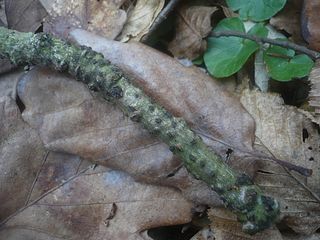
Valsaria insitiva is a plant pathogen, that causes perennial canker in apples and almonds.

René Charles Joseph Ernest Maire was a French botanist and mycologist. His major work was the Flore de l'Afrique du Nord in 16 volumes published posthumously in 1953. He collected plants from Algeria, Morocco, France, and Mali for the herbarium of the National Botanic Garden of Belgium.

Amanita persicina, commonly known as the peach-colored fly agaric, is a basidiomycete fungus of the genus Amanita with a peach-colored center. Until c. 2015, the fungus was believed to be a variety of A. muscaria.
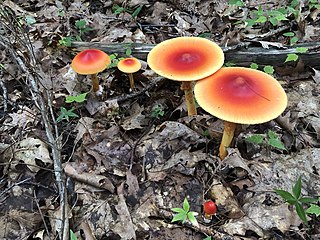
Amanita jacksonii, also known as Jackson's slender amanita, American Slender Caesar, and Eastern Caesar's Amanita, is a North American species of fungus in the family Amanitaceae. It is a reddish-orange colored mushroom species which can be identified by its yellow gills, large, white, sacklike volva.

Amanita crocea, the saffron ringless amanita, is a species of Amanita widely distributed in Europe. It is not recommended for consumption due to its similarity to poisonous species of the genus.
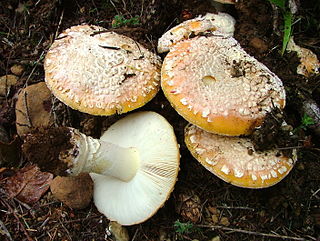
Amanita aprica, also known as the sunshine amanita, is a toxic species of fungus in the family Amanitaceae.

Amanita augusta is a small tannish-brown mushroom with cap colors bright yellow to dark brown and various combinations of the two colors. The mushroom is often recognizable by the fragmented yellow remnants of the universal veil. This mushroom grows year-round in the Pacific Northwest but fruiting tends to occur in late fall to mid-winter. The fungus grows in an ectomycorrhizal relationship with hardwoods and conifers often in mixed woodlands.
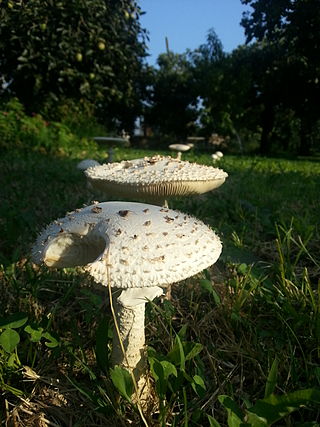
The genus Saproamanita contains about 24 species of agarics and is one of six genera in the family Amanitaceae, of which the similar Amanita is also a member. Saproamanita differs from Amanita in that its species are saprophytic, and not ectomycorrhizal.
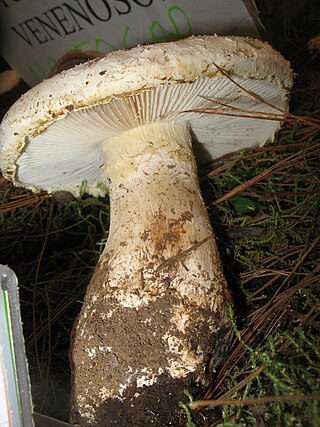
Amanita chlorinosma, also known as the chlorine lepidella or chlorine Amanita is a North American species of Amanita. Its life cycle is perennial. Its strong, unpleasant odor easily distinguishes it.

Amanita chrysoblema, with the common name American fly agaric, white variant, is a basidiomycete fungus of the genus Amanita. Although named chrysoblema, it is traditionally thought to be an Amanita muscaria variant, a group of fungi commonly known as fly agarics.

Amanita submembranacea is a species of fungus belonging to the family Amanitaceae.
Resinoporia crassa is a species of fungus belonging to the family Fomitopsidaceae.

Amanita princeps, the head man slender Caesar, is a species of agaric fungus in the genus Amanita. It is found in tropical China, Southeast Asia, and the Malay Peninsula down to Singapore. It is edible, and is collected in the wild and sold in local markets. Many incidents of mushroom poisoning have occurred among Laotian and Hmong immigrants to North America, since it is easily confused with Amanita phalloides, the death cap, in both appearance and odor.



















